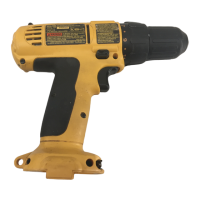11
However, if the outer seal is broken:
a. And the battery liquid gets on your skin,
immediately wash with soap and water for
several minutes.
b. And the battery liquid gets into your eyes, flush
minutes and seek immediate medical
attention.
(Medical note: The liquid is 25-35% solution of
potassium hydroxide.)
SPECIFIC SAFETY INSTRUCTIONS FOR
LITHIUM ION
(LI ION)
Do not incinerate the battery pack even if it is
severely damaged or is completely worn out.
fumes and materials are created when lithium
ion battery packs are burned.
If batte
ry contents come into contact with the
skin, immediately wash area with mild soap and
water. If battery liquid gets into the eye, rinse
water over the open eye for 15 minutes or until
irritation ceases. If medical attention is needed,
the battery electrolyte is composed of a mixture
of liquid organic carbonates and lithium salts.
Contents of opened battery cells may cause
respiratory irritation. Provide fresh air. If symptoms
persists, seek medical attention.
WARNING:
Battery cap (fig. 3)
A protective cap is supplied to cover the contacts of
a detached battery pack. Without the protective cap
in place, loose metal objects could short circuit the
contacts, causing a fire hazard and damaging the
battery pack.
Take off the protective cap ( m ) before placing
the battery pack ( i ) in the charger or tool.
Place the protective cap over the contacts
immediately after removing the battery pack from
the charger or tool.
Make sure the protective cap is in place
before storing or carrying a detached
battery pack.
Inserting and removing bits (fig. 4)
Open the chuck by turning the sleeve ( n )
counterclockwise and insert the bit shank.
them with clean water for a minimum of 10
The battery pack can explode in a fire. T
oxic
Burn hazard. Battery liquid
may be flammable if exposed to spark or
flame.
ENGLISH
Place the bit in the chuck as far as it will go and
lift slightly before tightening.
Tighten firmly by turning the sleeve clockwise.
To remove the bit, proceed in reverse order.
Selecting the operating mode or adjusting the
torque (fig. 5 )
The collar of this tool has 15 positions for the
adjustment of the torque to suit the size of the screw
and the workpiece material. For torque adjustment,
refer to the section “
“
Screwdriving .
Select the drilling mode or torque by aligning the
symbol or number on the collar (e) with the
indicator ( o ) on the housing.
Forward/reverse slider (fig. 6)
To select forward or reverse rotation, use the
forward/reverse slider (b) as shown (see arrows
on tool).
Always wait until the motor has come to
a complete standstill before changing the
direction of rotation.
Two gear selector (fig. 7)
Your tool is fitted with a two gear selector ( f ) to vary
the speed/torque ratio.
1 low speed/high torque (drilling large holes, driving
screws)
2 high speed/low torque (drilling smaller holes)
For speed rates, refer to the technical data.
Always push the two gear selector
completely forward or backward.
Do not change gears at full speed or
during use.
Instructions for use
Always observe the safety instructions
and applicable regulations.
Be aware of the location of pipework and
wiring.

